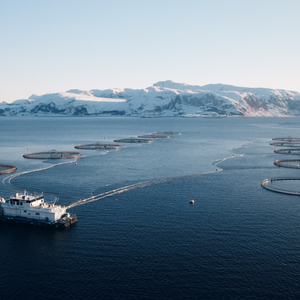Chinese Fishmeal Consumption in March Seen Significantly Higher Than Normal (2005/03/29)
In contrast to the normally slack fishmeal consumption and low fishmeal off-takes of around 40,000-50,000 MT from main Chinese ports in March, Chinese fishmeal consumption in this March has been significantly higher than normal along with total off-takes already hitting 91,000 MT by Mar. 27 and hopeful to reach 100,000 MT by end-March. The sharp jumps in Chinese fishmeal consumption in the normally slack fishmeal consumption season, as far as JCI analyzes, are mainly bolstered by the booming development of Chinese livestock breeding industries. In the meantime, the good prospect for Chinese aquaculture farming industries also provides firm support to Chinese fishmeal consumption as well. Such hiked fishmeal consumption in March accordingly buoys domestic fishmeal prices firm now under the declining soymeal market.
Since early year 2004, Chinese livestock breeding industries have witnessed booming development mainly owing to the fact that domestic pork consumption has seen marked rises following the decline in poultry meat consumption caused by the outbreak of bird flu cases in early year 2004. In the meantime, there continues to be quite satisfactory margins from livestock breeding along with breeding margins ever reaching RMB300 per head in late year 2004 and keeping at RMB150-200 per head at present, being much higher than the normally satisfactory margins of RMB100 per head. Mainly owing to the attractive margins from livestock breeding, domestic livestock feedstuff sales have seen marked rises since early March along with total sales of piglet feedstuff and concentrated feedstuff, especially in Southwest China's Sichuan and Yunan, Central China's Jiangxi and East China's Zhejiang, showing at least 50% of year-on-year rise. Accompanied with the rises in livestock feedstuff sales, total fishmeal consumption in livestock feedstuff production has jumped too along with average fishmeal consumption enlarged by at least 50% or even higher 100%-200% in some high-quality feedstuff. According to the information obtained by JCI, monthly fishmeal consumption by some large-sized feed mills have already increased to over 2,000 MT, already approaching to the level in peak fishmeal consumption season.
Besides the support from the booming development of livestock breeding industries, Chinese fishmeal market derives powerful support from the good prospect for aquaculture farming industries as well. As domestic prices for aquatic animals have maintained quite high since early this year and failed to see declines as what had occurred in previous years, there continues to be quite satisfactory margins from aquaculture farming as well. In that case, the overall breeding scale of aquaculture is expected to see year-on-year rise too, pushing most feed mills to advance their fishmeal stocks replenishment too.
The hiked fishmeal consumption in March has thus acted as the key bullish momentum in pushing domestic fishmeal prices up by around RMB1,000/MT from RMB5,500-5,600/MT in early March to the current RMB6,400-6,500/MT. Although most feed mills have been considering cutting down the usage of fishmeal in feedstuff production, total fishmeal consumption is still projected to be on the rise, as total feedstuff output is to show upward tendency. The high consumption has accordingly buoyed fishmeal prices firm at present too when soymeal prices have seen consecutive declines. (RMB8.28---US $1.00)
Chinese Fishmeal Market Awaits The Commence of Peruvian Fishing Season (2005/03/31)
At present time when Chinese fishmeal prices remain stable at the historically high RMB6,400-6,500/MT and Peru still hasn't started the new fishing season, most feed mills have shown little interest in fishmeal purchases along with attention focused on the commence of Peruvian fishing. Meanwhile, the weakness in Chinese soymeal market has increased most feed mills' cautiousness towards fishmeal purchases too before it becomes clear as regards the start of Peruvian fishing as well as status of fishing.
Following continuous rises for over a month, Chinese market prices for imported fishmeal have already increased to the historically high level at the time when there is still a period of time left for Chinese aquaculture farming industries to recover to the peak level. Seeing that Peru is soon to resume their normal fishing season in the near future, most Chinese feed mills thus show little interest in fishmeal purchases in domestic fishmeal market and focus their attention on the commence of Peruvian new fishing season in the hope that Peruvian fishmeal prices might weaken to some degree once the new fishing season starts.
In addition, Chinese soymeal market has remained quite weak recently along with soymeal quotes moving down from the general level of RMB2,900-3,100/MT on Mar. 18 to the current RMB2,700-2,850/MT in the south and east. The consecutive declines in soymeal prices have left the price ratio between imported fishmeal and soymeal at 2.2-2.3:1, lessening the competitiveness of imported fishmeal to some extent. In view of the weakness in soymeal prices, most feed mills thus appear inactive towards fishmeal buys too expecting that domestic fishmeal prices might follow the price downs in soymeal as well.
However, as far as JCI views, there is still room left for Peruvian fishmeal prices to see rises although Peruvian fishmeal offers have already surged by US $20/MT from early March to US $690/MT CNF China. Firstly, the trial fishing which is sponsored by Peruvian Marine Research Institute (IMAPRE) is hard to come to an end before April. 2, making it most likely for Peru to open the new fishing season till Apr. 10 and 11. Besides, Peru has already pre-sold up to around 300,000 MT of fishmeal with 200,000 MT to Chinese traders and feed mills and the trial fishing conducted by IMARPE shows that there is high percentage of juvenile fish, once total fishing volumes at the start of new fishing season turns out to be dissatisfactory, Peruvian fishmeal prices might start to see upward movement.
(RMB8.28---US $1.00)
Low Supply & High Costs Leave Local Fishmeal with Weakening Competitiveness (2005/04/07)
Together with the escalating prices for imported fishmeal, Chinese market prices for locally-produced fishmeal have also witnessed corresponding rises along with current prices mostly standing at above RMB6,000/MT or even higher RMB6,200-6,300/MT in East China's Shandong and Northeast China's Liaoning. Meanwhile, due to poor fish resources, there has been quite limited supply of fish animals along with fresh fish prices standing quite high, resulting in low supply and high costs for local fishmeal and weakening the competitiveness of local fishmeal in feedstuff production. Given the weakening competitiveness of local fishmeal, imported fishmeal is thus hopeful to have its market share increased to some degree.
Although fishing status along the coastal areas in China had ever seen certain improvement shortly after the Spring Festival, the Lunar New Year, total fishing volumes have again sunk to quite low level stepping into March. Under the influence, most large-sized fishmeal producers in East China's Shandong and Zhejiang have already halted their fishmeal production, resulting in quite low supply of local fishmeal. As far as JCI knows, the remaining amounts of local fishmeal in the hands of most fishmeal producers in East China are at least 50% less than that in the same period of a year earlier.
Apart from the lower-than-normal supply of local fishmeal, the production costs for local fishmeal have been on the rise due to the jumping prices for crude oil and anchovy. As far as JCI learns, the costs for fresh fish along the costal areas in Shandong have reached above RMB1,400/MT, being 40% higher than normal. Accordingly, the processing costs for fishmeal with superior quality stand at up to RMB6,200-6,300/MT, which might leave most fishmeal producers under losses. In order to lower fishmeal production costs and guarantee their margins, some fishmeal producers have come to make illegal blending of some other feather meal into fishmeal.
In view of the limited supply of local fishmeal as well as quite narrow price gap between imported fishmeal and local fishmeal, most feed mills have thus shown little interest in the purchases of local fishmeal. With market prices for imported fishmeal standing at RMB6,400-6,500/MT at most main ports, there is accordingly only around RMB300-400/MT of price gap between imported fishmeal and local fishmeal, let alone the great differences in the quality between imported fishmeal and local fishmeal. In that circumstance, the market share of imported fishmeal is sure to rise despite its hiked prices.
(RMB8.28---US $ 1.00)
Market Inquiries for Fishmeal at Chinese Ports Seen On the Rise Recently (2005/04/08)
Since late March, Chinese fishmeal market has remained relatively quiet along with fishmeal trade keeping quite thin at the historically high range of RMB6,400-6,500/MT. However, market inquiries for fishmeal at main Chinese ports have been seen on the rise recently according to the investigation made by JCI, which might be supported by the fast recovery in aquaculture farming industry. However, for fishmeal trade to see obvious rises, it might still take some time as domestic soymeal prices remain quite weak and feed mills still hold certain fishmeal stocks in hand.
After Chinese Tomb-sweeping Day of Apr. 5, the average temperatures have already recovered to quite high level of around 20 degree Celsius in East, Central and South China along with daily temperature highs even reaching 30 Celsius degrees, being quite suitable for aquaculture farming industry. In that case, Chinese aquaculture farming industry has already witnessed fast development in these areas, thus increasing feed mills' interests in fishmeal purchases. As far as JCI learns, most feed mills in South China have already started their production for aquatic feedstuff, pushing demand on fishmeal, especially on steam-dried fishmeal that is used for the production of feedstuff of shrimp feedstuff, to see obvious rises.
Meanwhile, the slim likelihood of purchasing Peruvian fishmeal for nearby shipment might also play a role in arousing feed mills' interest in inquiries for imported fishmeal at Chinese ports. Apart from the fact that Peruvian fishmeal offers have maintained as high as US $690-695/MT CNF China, there is nearly unlikely to settle Peruvian fishmeal purchases for shipment in nearby months, as there have been nearly no vessels available for shipment before June.
Despite the recent rises in market inquiries for imported fishmeal at the ports, it might still take some time before domestic fishmeal demand to see obvious rises. One reason lies in the fact that domestic soymeal prices have been quite weak with prices in Guangdong, already slipping to RMB2,750/MT. In view of the depression in soymeal market, most feed mills are now taking a wait-and-see attitude towards fishmeal buys. In addition, due to the delay in the overall start-up of aquaculture farming industry, most feed mills still hold certain stocks of fishmeal in hand to maintain their demand for half to one month, leaving them unlikely to enlarge their fishmeal purchases to a great extent in the short term.
(RMB8.28---US $ 1.00)
Source: Shanghai JC Inteligence Co. Ltd.










